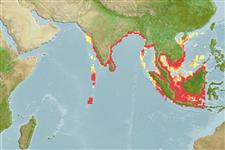Environment: milieu / Zona climática / intervalo de profundidade / distribution range
Ecologia
marinhas; Água doce; estuarina pelagic-neritic; anádromo (Ref. 51243); intervalo de profundidade 0 - 50 m (Ref. 188). Tropical; 24°N - 10°S, 70°E - 118°E (Ref. 188)
Indo-Pacific: Indian Ocean (Bombay to Bay of Bengal and Andaman coast of Thailand), Java Sea (off Java, Singapore). Sarawak, `Cochinchina' and Macao specimens (Ref. 6393) should be rechecked.
Tamanho / Peso / Idade
Maturidade: Lm ? range ? - ? cm
Max length : 36.5 cm SL macho/indeterminado; (Ref. 108866)
Descrição suscinta
Chaves de identificação | Morfologia | Morfometria
Espinhos dorsais (total) : 0; Espinhos anais: 0; Raios anais : 38 - 53. Body rather deep, belly with 19 to 23 + 8 to 12, total 28 to 35 (usually 30 to 34) scutes. Eye large, lower jaw strongly projecting. Dorsal fin origin near midpoint of body; anal fin origin below hind part of dorsal fin base. Swim bladder with a single long tube passing back down right side of body above anal fin base. No toothed hypo-maxilla.
Body shape (shape guide): fusiform / normal; Cross section: compressed.
An inshore species, but apparently occurs also in rivers (Ganges at Allahabad and rivers of eastern Uttar Pradesh, but not in Velar estuary). Ascends into the upper end of the tidal zone (Ref. 12693). Feeds on fishes, crustaceans, amphipods, occasionally polychaetes, tunicates and small amounts of algae and diatoms.
Ciclo de vida ou comportamento de acasalamento
Maturidade | Reprodução | Desova | Ovos | Fecundidade | Larvas
Whitehead, P.J.P., 1985. FAO Species Catalogue. Vol. 7. Clupeoid fishes of the world (suborder Clupeoidei). An annotated and illustrated catalogue of the herrings, sardines, pilchards, sprats, shads, anchovies and wolf-herrings. FAO Fish. Synop. 125(7/1):1-303. Rome: FAO. (Ref. 188)
Status na Lista Vermelha da UICN (Ref. 130435: Version 2025-1)
Ameaça para os humanos
Harmless
Uso pelos humanos
Pescarias: espécies comerciais
Ferramentas
Relatórios especiais
Baixar XML
Fontes da internet
Estimates based on models
Preferred temperature (Ref.
123201): 27.7 - 29.3, mean 28.8 °C (based on 614 cells).
Índice de diversidade filogenética (Ref.
82804): PD
50 = 0.5000 [Uniqueness, from 0.5 = low to 2.0 = high].
Bayesian length-weight: a=0.00832 (0.00555 - 0.01247), b=2.96 (2.84 - 3.08), in cm total length, based on LWR estimates for this species & Genus-body shape (Ref.
93245).
Nível Trófico (Ref.
69278): 3.0 ±0.37 se; based on food items.
Resiliência (Ref.
120179): médio(a), tempo mínimo de duplicação da população 1,4 - 4,4 anos (Preliminary K or Fecundity.).
Fishing Vulnerability (Ref.
59153): Low to moderate vulnerability (35 of 100).
🛈
Nutrients (Ref.
124155): Calcium = 132 [81, 261] mg/100g; Iron = 1.39 [0.82, 2.19] mg/100g; Protein = 19.2 [17.8, 20.6] %; Omega3 = 0.362 [0.193, 0.677] g/100g; Selenium = 41.4 [22.1, 83.1] μg/100g; VitaminA = 17.9 [7.0, 42.7] μg/100g; Zinc = 1.68 [1.23, 2.33] mg/100g (wet weight);
